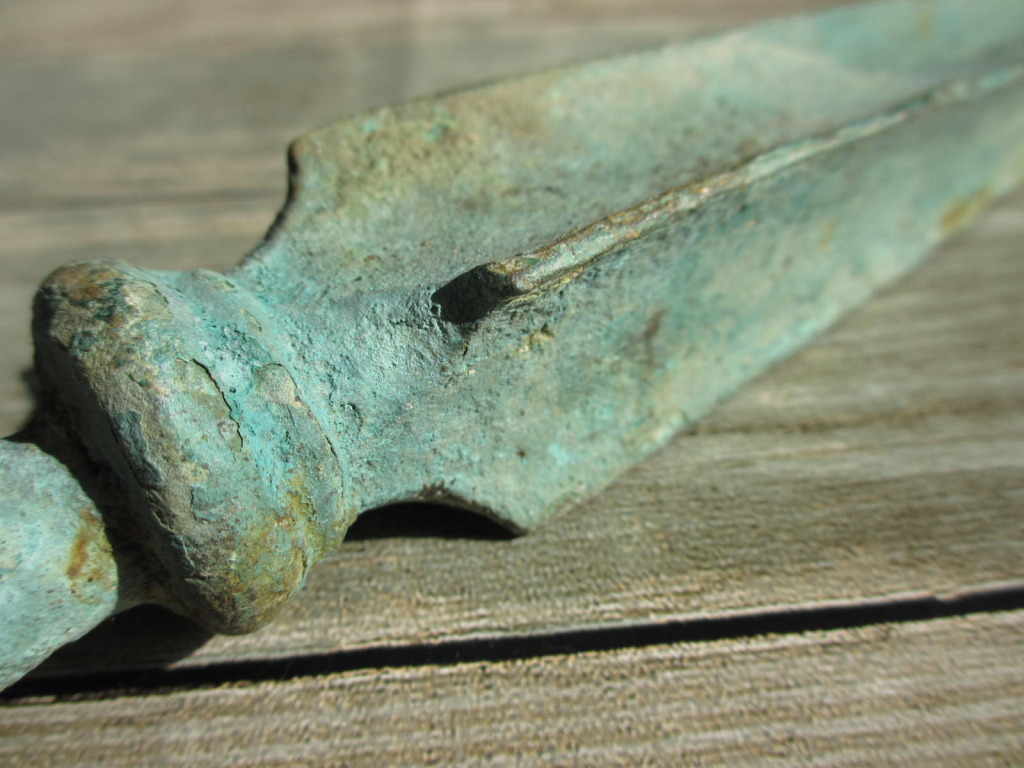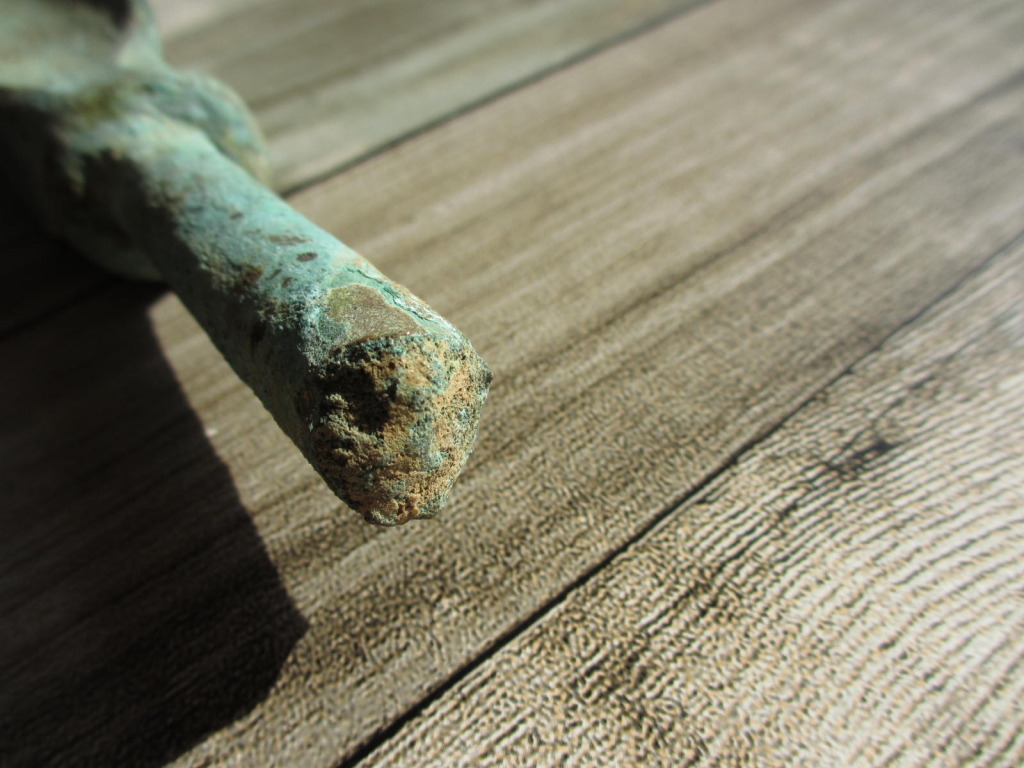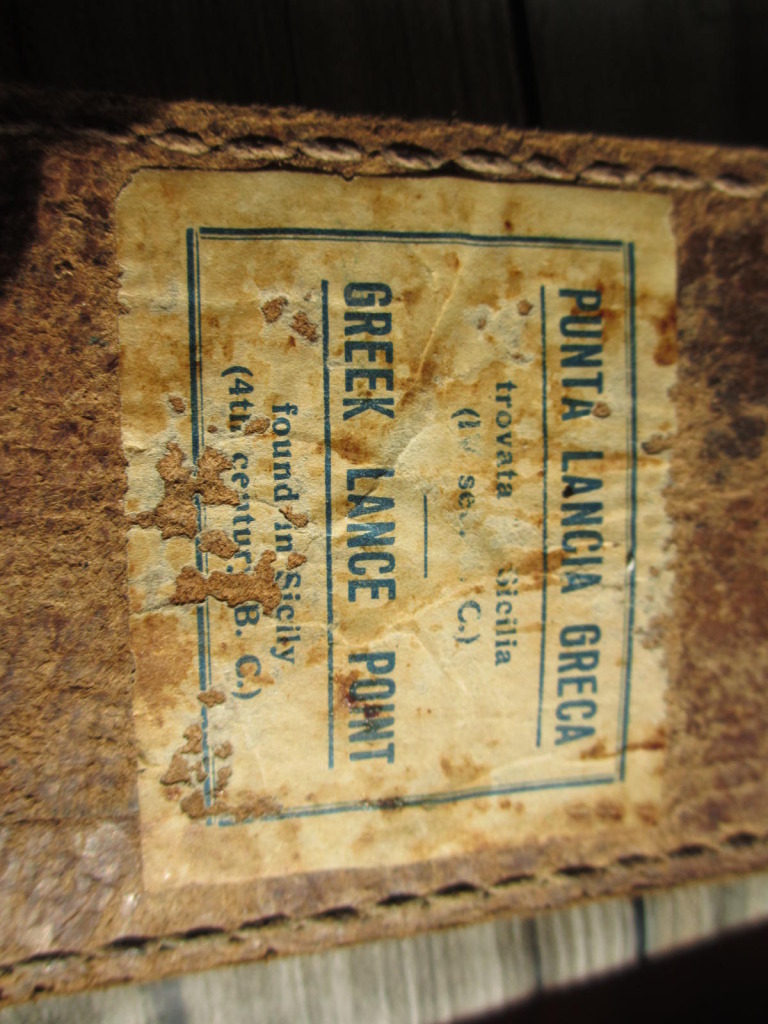| Author |
Message |
|
M Hermes
Location: The Netherlands Joined: 25 Aug 2011
Posts: 77
|
 Posted: Thu 30 Aug, 2012 7:47 am Post subject: Bronze spearhead Posted: Thu 30 Aug, 2012 7:47 am Post subject: Bronze spearhead |
 |
|
Hi,
today i bought this bronze spearhead from a garage sale. It can be placed in a leather scabbard with discription on the back that it was found in Sicily and that it's Greek. The leather scabbard and paper looks like it was made in the 1950s or 60s for the tourist market. The bronze spearhead is 33cm long and weighted 900 gram. It looks old but being placed in a leather scabbard with discription makes it a bit suspicious. what's the opinion over here and does anyone know what type of spear this is?
Thanks





|
|
   |
 |
|
Jeffrey Faulk
|
 Posted: Thu 30 Aug, 2012 8:43 am Post subject: Posted: Thu 30 Aug, 2012 8:43 am Post subject: |
 |
|
I'm *not* an expert, so bear that in mind...
That said, my guess is twofold, but for both options I think it can't be older than the 19th century at the VERY earliest.
First: It's some sort of architectural ornamentation. Looks sort of like the points you'd see on the top of a wrought-iron fence. The end of the 'socket' looks like it's solid bronze, which lends itself to this interpretation; it looks like it's been broken off of something. It's a little too symmetrical as well.
Secondly: Tourist-trap souvenir. The label obviously suggests this. The heavy encrusted patina also looks a tad artificial.
Greek spears would almost always have been a bit more leaf-shaped and flatter. I've never heard of any four-edged spear like this from there.
Now if the socket is just filled with dirt, you might have something a little more spear-like, but I'm still fairly sure this is pretty recent.
|
|
  |
 |
|
Matthew Amt
|
 Posted: Thu 30 Aug, 2012 9:27 am Post subject: Posted: Thu 30 Aug, 2012 9:27 am Post subject: |
 |
|
Yeah, my first impression was "flagpole finial". The outline makes me think of a spear buttspike rather than a spearhead, but I agree that the socket looks too narrow. And right, if the socket isn't hollow, it's not a spear part at all. The weight also seems awful heavy for a spear part. I'm assuming the date is pure guesswork--the 4th century BC is pretty late for bronze spearheads, though a few seem to show up here and there. Bronze was still used for buttspikes, but even those were often iron by that point.
Bottom line, I don't recall seeing any ancient spearhead with a cross-section quite like that, so I'd tend to be suspicious.
Matthew
|
|
   |
 |
|
M Hermes
Location: The Netherlands Joined: 25 Aug 2011
Posts: 77
|
 Posted: Thu 30 Aug, 2012 9:52 am Post subject: Posted: Thu 30 Aug, 2012 9:52 am Post subject: |
 |
|
|
The shaft is not hollow, so it's not possible that it was mounted on a pole in this condition. My best guess at this moment is that it was part of something bigger like Jeffrey sugested or a replica made to fool tourist. If it is a tourist "thing" i'm wondering why they tried to replicate something that was never in use as a weapon. It would be much easier to make a mold of a antique existing piece rather than make one yourself!?
|
|
   |
 |
|
Jeffrey Faulk
|
 Posted: Thu 30 Aug, 2012 11:06 am Post subject: Posted: Thu 30 Aug, 2012 11:06 am Post subject: |
 |
|
| Quote: | | It would be much easier to make a mold of a antique existing piece rather than make one yourself!? |
Who says they made a mold of an *antique*? :P
Either way you do have a rather interesting piece in its own right. Perhaps clean an inconspicuous area (the side you lay it down upon, perhaps) and see how it looks? I understand that genuine antique bronze tends to have a more deep green patina rather than this crusty stuff... looks almost like they just dunked it in a tank of acid or whatever and left it there to build up.
|
|
  |
 |
|
Matthew Amt
|
 Posted: Thu 30 Aug, 2012 12:31 pm Post subject: Posted: Thu 30 Aug, 2012 12:31 pm Post subject: |
 |
|
| M Hermes wrote: | | The shaft is not hollow |
Definitely not a weapon part, then. Most likely a fence spike.
| Quote: | | If it is a tourist "thing" i'm wondering why they tried to replicate something that was never in use as a weapon. It would be much easier to make a mold of a antique existing piece rather than make one yourself!? |
Only if you have access to antiquities in the first place! Which the vast majority of, uh, creative businessmen do not. Plus, since the vast majority of potential customers know almost nothing about antiquities, it's easy enough to fake something that looks old. There is currently a thriving business in fake antiques made from cheap Indian-made Roman and Greek "repros", bathing them in acid to give a nice green and rust finish. One of these was a glaringly obvious Windlass "trooper" helmet which ended up being bought by a museum for $50,000. Any reenactor would have spotted it in a second, but these highly-trained "experts" snapped it right up. (I'm in the wrong business....) This is all in addition to the fact that the vast majority of "historical reproductions" on the market are fantasy junk, and the manufacturers literally can't make it fast enough to keep up with the demand.
In this case, well, it could be an honest mistake! Someone may very well have dug it up in Sicily, and believed it to be a Greek spearhead. Stuff gets misidentified and misdated all the time. Heck, if I found something like that, I might be inclined to try to make it into a spearhead! Cut the shank off and braze on a socket, grind down those midribs a little, clean it all up. BUT since it is likely an antique even if it's modern, that's something that a lot of folks would be horrified by. On the other hand, it's YOURS, do what you like with it, eh?
Matthew
|
|
   |
 |
Dan Howard

|
 Posted: Thu 30 Aug, 2012 3:13 pm Post subject: Posted: Thu 30 Aug, 2012 3:13 pm Post subject: |
 |
|
|
I've seen fences with spikes exactly like this along the top - though usually made of wrought iron..
|
|
  |
 |
|
Eric W. Norenberg
|
 Posted: Thu 30 Aug, 2012 5:18 pm Post subject: Posted: Thu 30 Aug, 2012 5:18 pm Post subject: |
 |
|
| Dan Howard wrote: | | I've seen fences with spikes exactly like this along the top - though usually made of wrought iron.. |
Me too. And the chipping in the patina reminds me of a faux finish technique I've seen on concrete statuary, wood architectural details, and other decorator items.
Have you given it the magnet test? That will tell you if there is wrought iron under the green stuff - but it won't tell the difference between bronze or any non-ferrous pot metal, I'm afraid.
-Eric
|
|
  |
 |
|
M Hermes
Location: The Netherlands Joined: 25 Aug 2011
Posts: 77
|
 Posted: Fri 31 Aug, 2012 7:54 am Post subject: Posted: Fri 31 Aug, 2012 7:54 am Post subject: |
 |
|
I did the magnet test but it's not magnetic. It was cheap so i don't mind that it's probably fake. i learn a lot from "mistakes"like this.
Thank you all for your comment!
Marcel
|
|
   |
 |
Marik C.S.

|
 Posted: Fri 31 Aug, 2012 9:22 am Post subject: Posted: Fri 31 Aug, 2012 9:22 am Post subject: |
 |
|
Just to clarify something, a non-hollow shaft mustn't be a disqualifying criterion, or is it?
I'm not quite sure but I think I saw some spear from South East Asia on this site with a shaft like this which was to be inserted into a hollow handle.
While I have no doubt that this is a decorative ornament rather than a part of a weapon I'd just like to know whether I remembered that right or not.
Europe - Where the History comes from. - Eddie Izzard
|
|
    |
 |
|
Matthew Amt
|
 Posted: Fri 31 Aug, 2012 11:40 am Post subject: Posted: Fri 31 Aug, 2012 11:40 am Post subject: |
 |
|
Couldn't tell you about Asia, but European spearheads went from tanged to socketed pretty early (2000 BC?), and never went back. Tangs also tend to be much narrower than that.
Matthew
|
|
   |
 |
|
Timo Nieminen
|
 Posted: Fri 31 Aug, 2012 6:23 pm Post subject: Posted: Fri 31 Aug, 2012 6:23 pm Post subject: |
 |
|
Yes, there are tanged spearheads. Common in sub-Saharan Africa, southern India, SE Asia, Indonesia, Philippines, Japan, ancient Near East/Middle East, North America. But the big round rod on this is not a tang - far too fat.
The spear shaft must be wide enough so that there is enough material around the tang for strength - maybe a hole for round tangs about 1/3 the width of the tip of the (tapered) shaft is fairly normal, and these are usually reinforced by wire/cord/sinew wraps or a metal or rawhide sleeve.
Metal spear butts are usually socketed even in places where tanged heads are common. I don't think I've ever seen a tanged spear butt, but they are used in some places in Africa.
"In addition to being efficient, all pole arms were quite nice to look at." - Cherney Berg, A hideous history of weapons, Collier 1963.
|
|
   |
 |
|
|

